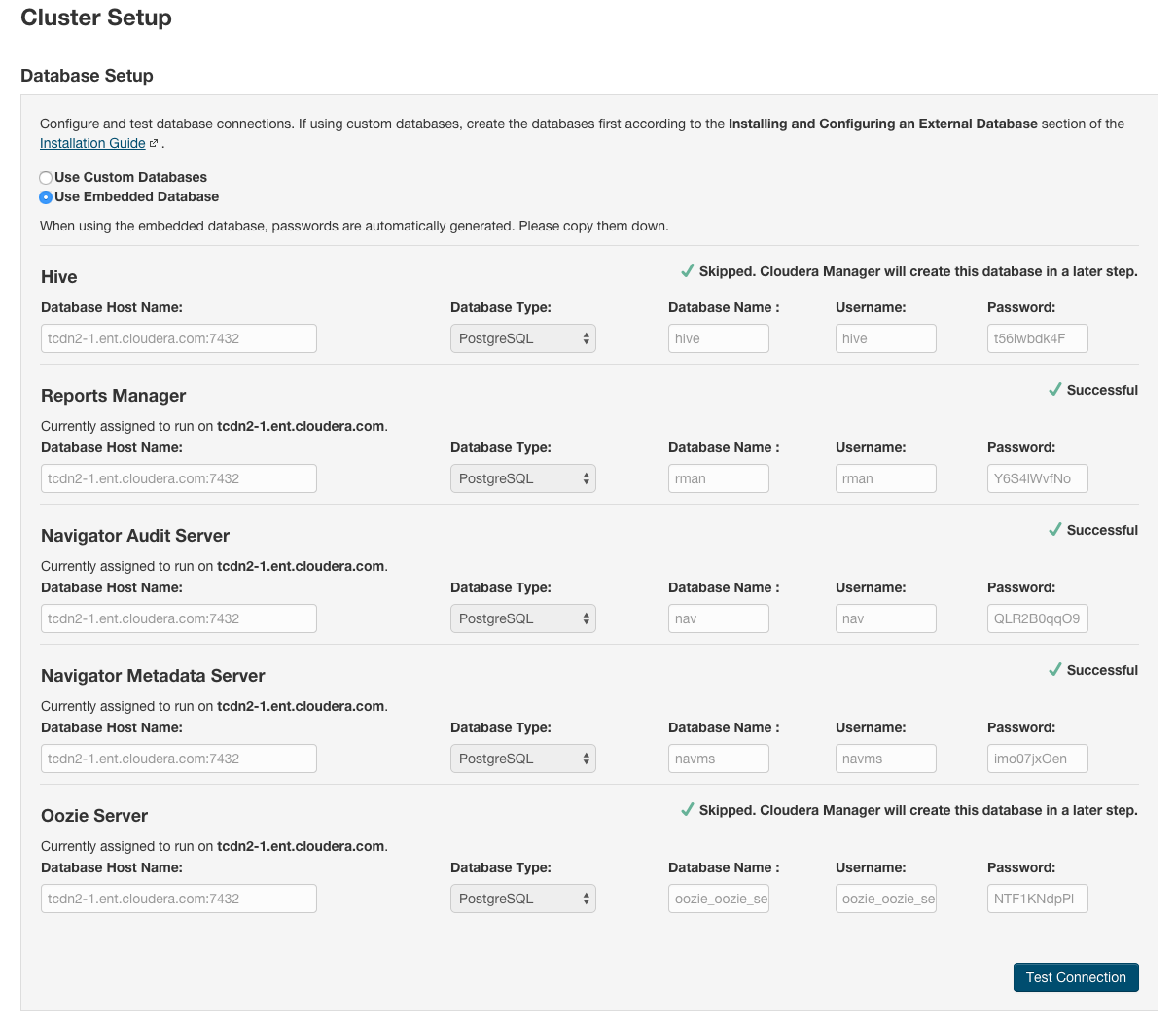Managing the Embedded PostgreSQL Database
Stopping the Embedded PostgreSQL Database
- Stop the services that have a dependency on the Hive metastore (Hue, Impala, and Hive) in the following order:
- Stop the Hue and Impala services.
- Stop the Hive service.
- Stop the Cloudera Management Service.
- Stop the Cloudera Manager Server.
- Stop the Cloudera Manager Server database:
sudo service cloudera-scm-server-db stop
Starting the Embedded PostgreSQL Database
- Start the Cloudera Manager Server database:
sudo service cloudera-scm-server-db start
- Start the Cloudera Manager Server.
- Start the Cloudera Management Service.
- Start the services that have a dependency on the Hive metastore (Hue, Impala, and Hive) in the following order:
- Start the Hive service.
- Start the Hue and Impala services.
Changing Embedded PostgreSQL Database Passwords
The embedded PostgreSQL database has generated user accounts and passwords. You can see the generated accounts and passwords during the installation process and you should record them at
that time. For example:

To find information about the PostgreSQL database account that the Cloudera Manager Server uses, read the /etc/cloudera-scm-server/db.properties file:
# cat /etc/cloudera-scm-server/db.properties Auto-generated by scm_prepare_database.sh # Sat Oct 1 12:19:15 PDT 201 # com.cloudera.cmf.db.type=postgresql com.cloudera.cmf.db.host=localhost:7432 com.cloudera.cmf.db.name=scm com.cloudera.cmf.db.user=scm com.cloudera.cmf.db.password=TXqEESuhj5
To change a password associated with an embedded PostgreSQL database account:
- Obtain the root password from the /var/lib/cloudera-scm-server-db/data/generated_password.txt file:
# cat /var/lib/cloudera-scm-server-db/data/generated_password.txt MnPwGeWaip The password above was generated by /usr/share/cmf/bin/initialize_embedded_db.sh (part of the cloudera-scm-server-db package) and is the password for the user 'cloudera-scm' for the database in the current directory. Generated at Fri Jun 29 16:25:43 PDT 2012.
- On the host on which the Cloudera Manager Server is running, log into PostgreSQL as the root user:
psql -U cloudera-scm -p 7432 -h localhost -d postgres Password for user cloudera-scm: MnPwGeWaip psql (8.4.18) Type "help" for help. postgres=#
- Determine the database and owner names:
postgres=# \l List of databases Name | Owner | Encoding | Collation | Ctype | Access privileges -----------+--------------+----------+------------+------------+----------------------------------- amon | amon | UTF8 | en_US.UTF8 | en_US.UTF8 | hive | hive | UTF8 | en_US.UTF8 | en_US.UTF8 | nav | nav | UTF8 | en_US.UTF8 | en_US.UTF8 | navms | navms | UTF8 | en_US.UTF8 | en_US.UTF8 | postgres | cloudera-scm | UTF8 | en_US.UTF8 | en_US.UTF8 | rman | rman | UTF8 | en_US.UTF8 | en_US.UTF8 | scm | scm | UTF8 | en_US.UTF8 | en_US.UTF8 | template0 | cloudera-scm | UTF8 | en_US.UTF8 | en_US.UTF8 | =c/"cloudera-scm" : "cloudera-scm"=CTc/"cloudera-scm" template1 | cloudera-scm | UTF8 | en_US.UTF8 | en_US.UTF8 | =c/"cloudera-scm" : "cloudera-scm"=CTc/"cloudera-scm" (9 rows) - Set the password for an owner using the \password command. For example, to set the password for the
amon owner, do the following:
postgres=# \password amon Enter new password: Enter it again:
- Configure the role with the new password:
- In the Cloudera Manager Admin Console, select .
- Click the Configuration tab.
- In the Scope section, select the role where you are configuring the database.
- Select category.
- Set the Role Name Database Password property.
- Enter a Reason for change, and then click Save Changes to commit the changes.